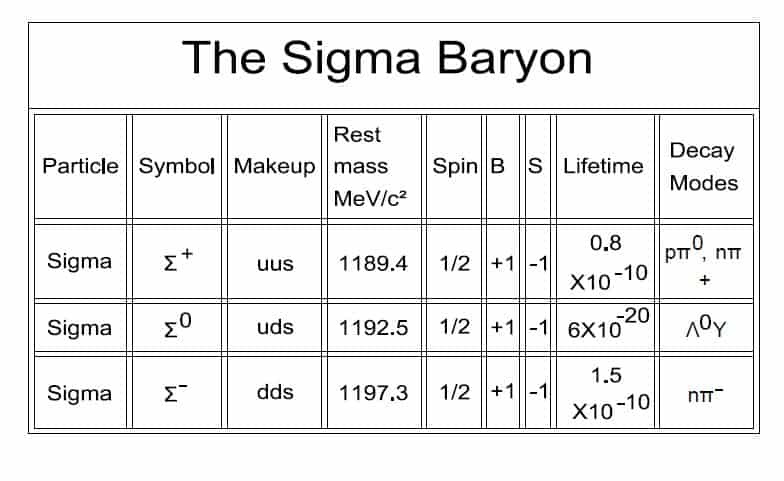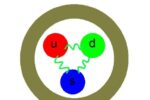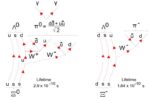Sigma Baryon, Properties, its Decay and Uniqueness.
In physics, the Sigma baryon (Σ baryon) is a type of baryon, which is a subatomic particle composed of three quarks. Baryons are part of the larger family of hadrons, which also includes mesons. The Sigma baryon is named after the Greek letter Sigma (Σ), which is used to denote its classification.
What is Sigma Baryon?
In physics, the Sigma baryon (Σ baryon) is a type of baryon, which is a subatomic particle composed of three quarks. Baryons are part of the larger family of hadrons, which also includes mesons. The Sigma baryon is named after the Greek letter Sigma (Σ), which is used to denote its classification.

Properties of Sigma Baryons:
Sigma baryons are characterized by the combination of three quarks, with their specific properties determining the different types of Sigma particles. The three quarks can be either up (u) or down (d) quarks, and the specific combination leads to different Sigma states. The three most common Sigma baryons are:
1. Sigma-plus (Σ+): Composed of two up quarks (u) and one strange quark (s).The quark composition of the Sigma-plus baryon is written as uds. The up quarks have a charge of +2/3, while the strange quark has a charge of -1/3. This means that the Sigma-plus baryon has a total charge of +1.
2. Sigma-zero (Σ0): Composed of one up quark (u), one down quark (d), and one strange quark (s).The quark composition of the Sigma-zero baryon is written as uds. The up quarks have a charge of +2/3, while the down quark has a charge of -1/3, and the strange quark has a charge of -1/3. This means that the Sigma-zero baryon has a total charge of 0.
3. Sigma-minus (Σ–): Composed of two down quarks (d) and one up quark (u).The quark composition of the Sigma-minus baryon is written as dds. The down quarks have a charge of -1/3, while the strange quark has a charge of -1/3. This means that the Sigma-minus baryon has a total charge of -1.
Each type of Sigma baryon has a different electric charge due to the combination of quarks.
Decay of Sigma Baryons:
Sigma baryons can undergo various decay processes. The exact decay modes and rates depend on the specific type of Sigma particle.
Sigma baryons decay through the weak interaction. The weak interaction or weak nuclear force is a short-range force that is responsible for the decay of unstable particles. The weak interaction can change the flavor of quarks, which is why Sigma baryons can decay into other baryons that have different strangeness values.
The specific decay channels for Sigma baryons depend on their charge and strangeness. The Sigma-plus (Σ+) baryon can decay into a proton and a pi-zero, or into a neutron and a pi+. The Sigma-zero (Σ0) baryon can decay into a Lambda baryon and a photon. The Sigma-minus (Σ–) baryon can decay into a neutron and a pi-minus, or into a Lambda baryon and a gamma ray.
The lifetimes of Sigma baryons are also different. The Sigma-plus baryon has a lifetime of about 8% of a nanosecond, the Sigma-zero baryon has a lifetime of about 7.4 nanoseconds, and the Sigma-minus baryon has a lifetime of about 2.4 nanoseconds.
The Sigma-zero (Σ0) baryon can decay through the weak interaction into a Lambda baryon and a photon. The decay process can be represented by the following Feynman diagram:
Σ0 → Λ + γ
The photon is emitted from the weak interaction between the strange quark and the up quark in the Sigma-zero baryon. The photon carries away the difference in mass between the Sigma-zero baryon and the Lambda baryon.
The branching ratio for the decay of the Sigma-zero baryon is 100%. This means that for every 100 Sigma-zero baryons that decay, all of them will decay into a Lambda baryon and a photon.
The lifetime of the Sigma-zero baryon is about 7.4 nanoseconds. This means that a Sigma-zero baryon will typically decay after about 7.4 millionths of a second.
The decay of the Sigma-zero baryon is an example of a weak decay. Weak decays are a type of decay that is caused by the weak nuclear interaction. The weak interaction is a short-range force that is responsible for the decay of unstable particles. The weak interaction can change the flavor of quarks, which is why Sigma baryons can decay into other baryons that have different strangeness values.
It’s worth noting that the Sigma-zero baryon is relatively short-lived and decays relatively quickly, as is typical for many hadrons that participate in weak decays. Experimental measurements and theoretical calculations have provided values for the lifetime and decay rate of the Sigma-zero baryon, which are consistent with the Standard Model of particle physics.
The Sigma-minus (Σ–) baryon can decay through
The Sigma-minus (Σ–) baryon can decay through the weak interaction into a neutron and a pi-minus, or into a Lambda baryon and a gamma ray. The decay process can be represented by the following Feynman diagrams:
Σ- → n + π-
Σ- → Λ + γ
The neutron and pi-minus are the most common decay products of the Sigma-minus baryon, with a branching ratio of about 99.848%. The Lambda baryon and gamma ray are less common decay products, with a branching ratio of about 0.152%.
The lifetime of the Sigma-minus baryon is about 2.4 nanoseconds. This means that a Sigma-minus baryon will typically decay after about 2.4 millionths of a second.
Uniqueness of Sigma Baryons:
Each type of baryon is unique based on the specific combination of quarks it contains. The Sigma baryons, with their distinct combinations of up (u), down (d), and strange (s) quarks, are different from other baryons like protons and neutrons, which are also baryons but have different combinations of quarks.
The study of Sigma baryons, along with other baryons and mesons, provides valuable insights into the strong nuclear force and the behavior of quarks within the framework of quantum chromodynamics (QCD), which is the theory that describes the strong force. These subatomic particles are extensively studied in high-energy physics experiments and are crucial for understanding the fundamental building blocks of matter.
Conclusion:
In conclusion, the Sigma baryon, an essential subatomic particle, exhibits intriguing properties and distinct decay patterns. Its uniqueness lies in its contribution to understanding the strong force and quark interactions. Further research on Sigma baryons is crucial to unlocking deeper insights into the fundamental nature of matter and the universe.



0 Comments